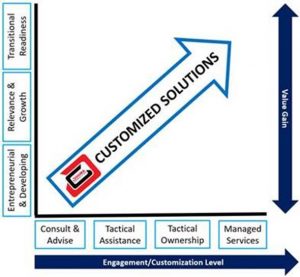Although the concept of Interim Management isn’t exactly new, the evolution of its practice and related use has certainly gained momentum over recent years. There has also been a blurring of the lines between an Interim Manager and that of a Management Consultant from what used to be a clear distinction. This is especially true in smaller markets where small to midsized companies are more prolific and the Interim Management and/or Management Consultant is independent and not part of a large firm. Where this is the case, there is less of an incentive to sell additional services which is many times not needed and often have little or no value to the client. Therefore, size, in this case being smaller, does in fact have its advantages.
 By way of definition, Interim Management is the temporary provision of management resources and skills for the short-term assignment of a proven heavyweight interim executive manager to manage a period of transition, crisis or change within an organization. A Management Consultant on the other hand practices helping organizations to improve their performance, operating primarily through the analysis of existing organizational problems, and the development of plans for improvement within the consultants’ specialized area of expertise. As you can see the differences tend to focus less on that of the service area delivered and more on the level of the execution engagement as it relates to the organizational hierarchy. Historically, Interim Management has been typically reserved for “C” level oversight.
By way of definition, Interim Management is the temporary provision of management resources and skills for the short-term assignment of a proven heavyweight interim executive manager to manage a period of transition, crisis or change within an organization. A Management Consultant on the other hand practices helping organizations to improve their performance, operating primarily through the analysis of existing organizational problems, and the development of plans for improvement within the consultants’ specialized area of expertise. As you can see the differences tend to focus less on that of the service area delivered and more on the level of the execution engagement as it relates to the organizational hierarchy. Historically, Interim Management has been typically reserved for “C” level oversight.
Be it leveraging said expertise to remain relevant within growth & sustainability cycles, or to be better positioned for transitional readiness opportunities, either can be used to bring in a nonbiased perspective. This can aid in the identification of problems and the related analysis into their root cause(s), in order to give value-add recommendations for strategizing more clearly and operating in more effective or efficient ways. Many times businesses fail to think holistically and initially efforts tend to focus on business plans as a means to secure financing and, once in place, there is often a leap made to daily tactical exercises and related rhythms. The work “leap” is a key here, as being successful using this approach is many times a leap of faith and the gap between funding and executing are immense; failure is almost a forgone conclusion. Many times the use of an Interim Manager or a Management Consultant can be the bridge that successfully connects the two disparate areas of focus. But what if there is a better, more flexible way?
It is increasingly becoming the case that small consulting firms which specialize in both interim management and offer operational execution services have a unique advantage. This comes from the ability to leverage executive knowledge and thought leadership as well as possessing implementation agility. These firms typically have leaders who can tap into vast corporate experience and have in place an operational staff who can not only aide in execution, but have the ability to own and manage the end to end implementation value chain. By offering clients a choice relative to the levels of engagement, it turns the discussion from choosing between “this” or “that”, into one of leveraging “the power of AND”; again, through both Interim Management and Operational Execution services. There is incredible value in offering a holistic approach that is specifically modified to the needs and desires of the client. This multi-layered approach, by way of both service offerings and customized engagement, is the sweet spot that a hybrid model gives, yet few offer. Further, this approach is building a positive reputation and industry awareness for effective strategic management and quick operational results.
Leveraging “The Power of And”
In finding the appropriate balance between interim management and hands on operational execution, the hybrid approach allows for solutions that enable businesses to grow, operate more efficiently and maximize profits in order to succeed in today’s competitive marketplace. Where Interim Management defines the scope, strategy, and gives executional direction, operational execution provides implementation excellence through proven business principles and best practices. The two work together via the orchestrated handoffs of evaluating potential challenges, identifying root causes, and ultimately developing the operational plan to address and solve them.
Agile and focused on results, the hybrid model offers:
- Immediate Experience – Provides the stop-gap for businesses who must keep projects and goals on track while they conduct the proper search of the right candidate to take over permanently.
- Outside Perspective – Brings new and innovative ideas or possible challenges to the table that businesses might not have been able to see on their own. In doing so it focuses on fixing the root of a problem rather than redistributing full time staff to spend time working on symptomatic issues.
- Lower Cost – Offers short term organizational and project leadership and hands on expertise without the burdens and costs associated with managing fulltime employees.
- Greater Flexibility – Offers resources that are capable of moving across organizations, departments, and disciplines to address multiple projects.
- Workforce Friendly – By providing flexible contracts, it allows companies to avoid the associated impacts and costs, both financial as well as morale and productivity, as a result of having to lay off fulltime employees.

This hybrid approach also offers clients uniformity and continuity throughout the experience. By offering customized levels of engagement, starting from the perspective of consulting “to advise” (the early stages of Interim Management) through that of tactical managed services (complex operational sustainability), as the level of engagement increases, so do the value gains when measuring the related ROI. From early discovery to that of change management, lessons learned, and contract closure, this model provides and maintains direct line of sight throughout the engagement lifecycles and is essential for success. Further, it is essential for management to understand the value of an integrated approach. “Understanding a concept and getting questions answered is quite different from having the mindset, tools and ability to create a strategy and then execute the strategy.” says Amber Barnes of StartHuman. “People often confuse knowing and doing, and the differences are vast.”
By using either in-house staff, or having the ability to leverage the advantages of a small firm’s project management office (PMO) resource to assist with implementation there are soft benefits that can’t be underestimated. Not the least of which is agility which maps directly to said continuity of experience. Being present throughout the process also allows the firm to better integrate the knowledge of internal subject matter experts (SMEs) as a continuous validation point for changes to policy, procedures and alike. After all, the end goal is to aid the client in solving root cause problems and implement sustainable solutions. Using SMEs as a valued leverage point is critical in being both inclusive and transparent; their voice is probably the most important in redefining models and must not be hindered.
As companies continuing to evolve, so must the way they approach and overcome operational challenges. This approach must include a holistic shift in how they give thought to decisions pertaining to strategy, continued innovation, and those capabilities which will push the boundaries of organizational design and staffing practices. Might the hybrid Interim Management be the best approach?
There is a realization that the use of talent in this way can be more strategic and many now consider including independent firms in many of their staffing conversations. As shifts take place it enables a business to be more agile in ambiguous situations, giving flexibility in decisions around human capital investments. These professionals typically have the bandwidth to really focus on the client, are free from administrative chores that big-firm engagement usually entail, and thus are far more present in rolling up their sleeves for the client. Simply, the model described lets companies adapt to change more quickly because, as we all know, change is inevitable.
